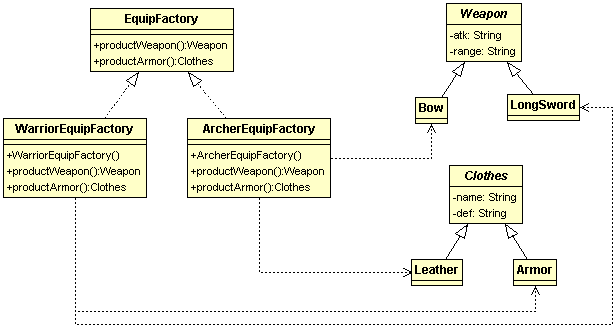抽象工廠模式 Abstract Factory Pattern 1
目的:用一個工廠介面來產生一系列相關的物件,但實際建立哪些物件由實作工廠的子類別來實現
出發冒險之前,一定要有裝備
有了冒險者之後,他們還需要各種裝備才能出門探險,假如一個冒險者需要武器、頭盔、上衣、褲子、鞋子5種裝備, 村莊內又有4種不同專業的冒險者,這樣我們就要建立20種工廠類別來生產裝備,而且每增加一種冒險者類別, 就要多增加5個實體工廠類別,如果使用剛才的工廠模式來管理生產裝備,實體工廠類別就會變非常得多,這時候有點經驗的程式設計師就會意識到程式碼可能因此變雜亂不易維護。 在這種情境之下,工廠模式不能解決我們的問題,因此這邊改變一下工廠的定義,首先工廠仍然只是一個抽象介面(Factory),但是介面規定工廠現在生產的不是一種產品, 而是生產一個冒險者類別一系列所有的裝備,也就是說一間工廠要生產武器、頭盔、上衣、褲子、鞋子5種裝備(Product), 當然有了抽象工廠介面後當然也需要實體工廠(ConcreteFactory),例如說鬥士裝備生產工廠就會生產一系列的鬥士裝備(ConcreteProduct) ,這就是抽象工廠模式。 以下範例讓我偷懶一下,一個冒險者只有武器與上衣兩種裝備就好。
類別圖

程式碼
產品介面與實體產品類別
/**
* 上衣介面(Product)
*/
public abstract class Clothes {
protected int def; // 防禦力
/**
* 展示這件衣服
*/
public void display(){
System.out.println(this.getClass().getSimpleName() + " def = " + def);
}
// 以下省略getter setter
}
/**
* 盔甲(ConcreteProduct)-鬥士上衣
*/
public class Armor extends Clothes {
}
/**
* 皮甲(ConcreteProduct)-弓箭手上衣
*/
public class Leather extends Clothes {
}
/**
* 武器介面(Product)
*/
public abstract class Weapon {
protected int atk; // 攻擊力
protected int range; // 攻擊範圍
/**
* 展示武器
*/
public void display(){
System.out.println(this.getClass().getSimpleName() + " atk = " + atk + " , range = " + range);
}
// 以下省略getter setter
}
/**
* 長劍(ConcreteProduct)-鬥士武器
*/
public class LongSword extends Weapon {
}
/**
* 弓(ConcreteProduct)-弓箭手武器
*/
public class Bow extends Weapon {
}
工廠介面與實體工廠類別
/**
* 裝備工廠介面(Factory)-定義每一間工廠應該生產哪些東西
*/
public interface EquipFactory {
/**
* 製造武器
*/
Weapon productWeapon();
/**
* 製造衣服
*/
Clothes productArmor();
}
/**
* 專門生產鬥士裝備的工廠(ConcreteFactory)
*/
public class WarriorEquipFactory implements EquipFactory{
@Override
public Weapon productWeapon() {
LongSword product = new LongSword();
product.setAtk(10);
product.setRange(1);
return product;
}
@Override
public Clothes productArmor() {
Armor product = new Armor();
product.setDef(10);
return product;
}
}
/**
* 專門生產弓箭手裝備的工廠(ConcreteFactory)
*/
public class ArcherEquipFactory implements EquipFactory{
@Override
public Weapon productWeapon() {
Bow product = new Bow();
product.setAtk(10);
product.setRange(10);
return product;
}
@Override
public Clothes productArmor() {
Leather product = new Leather();
product.setDef(5);
return product;
}
}
測試碼留在抽象工廠模式 2再做測試。
工廠模式與抽像工廠模式比較:
工廠模式:工廠模式注重的是如何產生一個物件,例如弓箭手訓練營只要負責如果生產出弓箭手。
抽像工廠模式:抽像工廠模式注重在產品的抽象關係,像武器與衣服本來是扯不上關係的兩種物品,不過這兩種物品都是屬於同一種冒險者的裝備,因此他們就有了這層抽象關係。